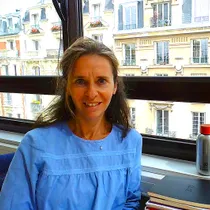Presentation

Our team explores how the cytoskeleton is organized, how it controls the establishment of functional membrane domains devoted to polarized cell growth or cell division, and how it is remodeled at mitotic entry for the assembly of the mitotic spindle and contractile ring, two complex molecular machines promoting chromosome segregation and cytokinesis. Most our studies are performed in the fission yeast where cell organization is stereotyped and the cytoskeleton relatively simple.
We combine classical molecular genetics with state-of-the-art live cell microscopy approaches in combination with micro-fabricated devices to control cellular environment. More recently, we have started exploring evolutionary conserved pathways in mammalian cells.
Microtubule-based functions (Phong Tran).
We are interested in understanding how cell polarity and cell division are orchestrated by the cytoskeleton. Our previous studies in fission yeast have shown that bundles of microtubules can direct new sites of actin-dependent polarized cell growth; and microtubules organize the mitotic spindle for chromosome segregation. Cytoskeletal architecture and dynamics are influenced by associated proteins such as motors and bundlers, and regulatory proteins such as kinases and phosphatases. A long-term goal is to understand the molecular mechanisms by which these proteins function, and establish potential evolutionary conservation between yeast and man. Our plan is to (1) identify the molecular components of the cell shape and cell division pathway, (2) define the interactions of known (and newly discovered) cytoskeletal proteins and their roles in cell polarity and cell division, and (3) develop and apply advanced optical imaging analysis, and nanotechnology methods to the yeast and mammalian cell systems (Fig. 2).
Spatio-temporal regulation of cell division (Anne Paoletti)
Our aim is to determine how cell division is controlled in time and space to guarantee a correct segregation of chromosomes and an equal partitioning of the cytoplasm between sister cells. Our past work showed that in fission yeast, it involves medial cortical nodes organized by the SAD kinase Cdr2 and the anillin-like protein Mid1 that define the position of the division plane in interphase and trigger medial assembly of the contractile ring during mitosis. Cdr2 nodes are restricted to the medial cortex by the DYRK kinase Pom1 which forms gradients emanating from the cell tips (Figure 3). Our most recent work shows that Pom1 prevents Cdr2 node assembly at cell tips by reducing Cdr2 affinity for membrane lipids and down-regulating Cdr2 clustering abilities depending on interactions with Mid1. Interestingly, Cdr2 also favors mitotic entry by inhibition of Wee1. This function is also inhibited by Pom1. However, Pom1 inhibition is relieved upon cell growth, allowing entry into mitosis and coupling mitosis entry to cell size. Our goal is now to characterize the function of additional components of medial cortical nodes that participate in division plane positioning or mitotic promoting functions. We also want to understand the signaling cascades and molecular mechanisms at play to remodel the nodes at mitotic entry when the contractile ring starts assembling. We finally plan to address the evolutionary conservation of these pathways regulating cell division in higher Eukaryotes.














